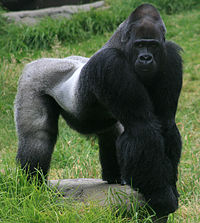
Photo from wikipedia
Humans were once considered unique in having a concept of death but a growing number of observations of animal responses to dying and dead conspecifics suggests otherwise. Complex arrays of… Click to show full abstract
Humans were once considered unique in having a concept of death but a growing number of observations of animal responses to dying and dead conspecifics suggests otherwise. Complex arrays of behaviors have been described ranging from corpse removal and burial among social insects to quiet attendance and caregiving among elephants and primates. Less frequently described, however, are behavioral responses of individuals from different age/sex classes or social position toward the death of conspecifics. We describe behavioral responses of mountain gorillas (Gorilla beringei beringei) to the deaths of a dominant silverback and a dominant adult female from the same social group in Volcanoes National Park in Rwanda and the responses of Grauer’s gorillas (Gorilla b. graueri) to the corpse of an extra-group silverback in Kahuzi-Biega National Park, Democratic Republic of Congo. In gorillas, interactions between groups or with a lone silverback often result in avoidance or aggression. We predicted that: (i) more individuals should interact with the corpses of same-group members than with the corpse of the extra-group silverback; (ii) adult females with infants should avoid the corpse of the extra-group silverback; and (iii) in the mountain gorilla cases, individuals that shared close social relationships with the dead individual should spend more time with the corpse than other individuals in the group. We used a combination of detailed qualitative reports, photos, and videos to describe all occurrences of affiliative/investigative and agonistic behaviors observed at the corpses. We observed similar responses toward the corpses of group and extra-group individuals. Animals in all three cases showed a variety of affiliative/investigative and agonistic behaviors directed to the corpses. Animals of all age/sex classes interacted with the corpses in affiliative/investigative ways but there was a notable absence of all adult females at the corpse of the extra-group silverback. In all three cases, we observed only silverbacks and blackbacks being agonistic around and/or toward the corpses. In the mountain gorilla cases, the individuals who spent the most time with the corpses were animals who shared close social relationships with the deceased. We emphasize the similarity in the behavioral responses around the corpses of group and extra-group individuals, and suggest that the behavioral responses were influenced in part by close social relationships between the deceased and certain group members and by a general curiosity about death. We further discuss the implications close interactions with corpses have for disease transmission within and between gorilla social groups.
Journal Title: PeerJ
Year Published: 2019
Link to full text (if available)
Share on Social Media: Sign Up to like & get
recommendations!